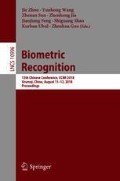Abstract
Gait is an important biometrics in human identification, but the view variation problem seriously affects the accuracy of gait recognition. Existing methods for multi-view gait-based identification mainly focus on transforming the features of one view to another view, which might be unsuitable for the real applications. In this paper, we propose a multi-view gait recognition method based on RBF network that employs a unique view-invariant model. First, extracts the gait features by calculating the gait individual image (GII), which could better capture the discriminative information for cross view gait recognition. Then, constructs a joint model, use the DLDA algorithm to project the model and get a projection matrix. Finally, the projected eigenvectors are classified by RBF network. Experiments have been conducted in the CASIA-B database to prove the validity of the proposed method. Experiment results shows that our method performs better than the state-of-the-art multi-view methods.
Access this chapter
Tax calculation will be finalised at checkout
Purchases are for personal use only
References
Tafazzoli, F., Safabakhsh, R.: Model-based human gait recognition using leg and arm movements. Eng. Appl. AI 23(8), 1237–1246 (2010)
Yam, C.Y., Nixon, M.S., Carter, J.N.: Automated person recognition by walking and running via model-based approaches. Pattern Recogn. 37(5), 1057–1072 (2004)
Han, J., Bhanu, B.: Individual recognition using gait energy image. IEEE Trans. Pattern Anal. Mach. Intell. 28(2), 316–322 (2006)
Zhang, E., Zhao, Y., Xiong, W.: Active energy image plus 2DLPP for gait recognition. Signal Process. 90(7), 2295–2302 (2010)
Wang, C., Zhang, J., Wang, L.: Human identification using temporal information preserving gait template. IEEE Trans. Pattern Anal. Mach. Intell. 34(11), 2164–2176 (2012)
Yu, S., Tan, D., Tan, T.: A framework for evaluating the effect of view angle, clothing and carrying condition on gait recognition. In: ICPR, vol. 4, pp. 441–444 (2006)
Bodor, R., Drenner, A., Fehr, D.: View-independent human motion classification using image-based reconstruction. Image Vis. Comput. 27(8), 1194–1206 (2009)
Zhang, Z., Troje, N.F.: View-independent person identification from human gait. Neurocomputing 69(1–3), 250–256 (2005)
Zhao, G., Liu, G., Li, H.: 3D gait recognition using multiple cameras. In: FG, pp. 529–534 (2006)
Makihara, Y., Sagawa, R., Mukaigawa, Y., Echigo, T., Yagi, Y.: Gait recognition using a view transformation model in the frequency domain. In: Leonardis, A., Bischof, H., Pinz, A. (eds.) ECCV 2006. LNCS, vol. 3953, pp. 151–163. Springer, Heidelberg (2006). https://doi.org/10.1007/11744078_12
Kusakunniran, W., Wu, Q., Li, H.: Support vector regression for multi-view gait recognition based on local motion feature selection. In: CVPR, pp. 974–981 (2010)
Kusakunniran, W., Wu, Q., Zhang, J.: Gait recognition under various viewing angles based on correlated motion regression. IEEE Trans. Circ. Syst. Video Technol. 22(6), 966–980 (2012)
Bashir, K., Xiang, T., Gong, S.: Cross view gait recognition using correlation strength. In: BMVC, pp. 1–11 (2010)
Zhang, Z., Chen, J., Wu, Q.: GII representation-based cross-view gait recognition by discriminative projection with list-wise constraints. IEEE Trans. Cybern. 88(99), 1–13 (2017)
Portillo-Portillo, J., Leyva, R., Sanchez, V.: Cross view gait recognition using joint-direct linear discriminant analysis. Sensors 17(1), 6 (2017)
Tao, D., Li, X., Wu, X.: General tensor discriminant analysis and gabor features for gait recognition. IEEE Trans. Pattern Anal. Mach. Intell. 29(10), 1700–1715 (2007)
Alldrin, N., Smith, A., Turnbull, D.: Classifying facial expression with radial basis function networks, using gradient descent and K-means (2003)
Yu, S., Wang, Q., Shen, L.: View invariant gait recognition using only one uniform model. In: ICPR, pp. 889–894 (2016)
Author information
Authors and Affiliations
Corresponding author
Editor information
Editors and Affiliations
Rights and permissions
Copyright information
© 2018 Springer Nature Switzerland AG
About this paper
Cite this paper
Qiu, Y., Song, Y. (2018). Multi-view Gait Recognition Method Based on RBF Network. In: Zhou, J., et al. Biometric Recognition. CCBR 2018. Lecture Notes in Computer Science(), vol 10996. Springer, Cham. https://doi.org/10.1007/978-3-319-97909-0_11
Download citation
DOI: https://doi.org/10.1007/978-3-319-97909-0_11
Published:
Publisher Name: Springer, Cham
Print ISBN: 978-3-319-97908-3
Online ISBN: 978-3-319-97909-0
eBook Packages: Computer ScienceComputer Science (R0)

